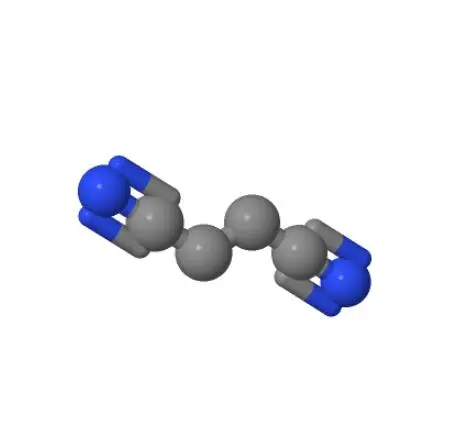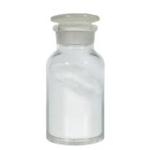Succinonitrile Uses and Related Research
Introduction of Succinonitrile
Succinonitrile is a colourless to light brown crystalline or colourless waxy solid compound. It is highly toxic and is commonly used in materials chemistry or engineering technology to make plastics and nitrocellulose fibres. It is also used as an electrolyte additive in composite fibre membranes for lithium ion batteries.

Related Research
Succinonitrile-based plastic crystal electrolytes have emerged for high-energy-density Li metal batteries in terms of their superior ambient ionic conductivity, low flammability, and benign compatibility with high voltage cathode, but are hampered by inherent instabilities toward Li anodes. Constructing hierarchical solid electrolytes structure is a fundamental approach to protect Li anode from succinonitrile attacks, with succinonitrile-based oxidation-resistance layer facing high voltage cathode and reduction-tolerant layer contacting Li anode. However, free succinonitrile molecules in succinonitrile-based electrolyte layer can diffuse across the electrolyte/electrolyte interface and further reach Li anode surface during the battery cycle. This chemical “crosstalk” cause reduction-tolerant electrolyte layer to fail to protect the Li anode from the attacks of free succinonitrile molecules. Nano Li6.4La3Zr1.4Ta0.6O12 is introduced creatively into succinonitrile-based electrolyte layer. By taking advantage of the complexation between La atoms in Li6.4La3Zr1.4Ta0.6O12 and N atoms in succinonitrile, the free succinonitrile molecules are successfully immobilized in succinonitrile-based electrolyte layer. The resulting low resistance and highly durable solid electrolyte interphase and cathode electrolyte interphase endow NCM622||Li batteries with remarkable cycle stability. Our research provides a new idea for the real application of plastic crystal electrolytes in high voltage solid-state lithium metal batteries.
Transparent gel electrolytes have the advantage of optical transparency, higher ionic conductivity, and better electrode adhesion compared with solid inorganic electrolytes, which is of great significance in solid-state electrochromic glass and other electrochemical applications. Here, succinonitrile-modified polyacrylate gel polymer electrolyte (SN-GPE) has been successfully synthesized via an in-situ thermal polymerization under mild conditions. Adopted succinonitrile significantly improves ionic conductivity from 0.02 mS·cm−1 to 4.02 mS·cm−1, maintaining advantageous features such as high transparency and excellent electrochemical performance. The optimized SN-GPEs with good adhesion to both counter and working electrodes were assembled in semi-devices with a configuration of glass/FTO/WO3/SN-GPE/FTO/glass, which showed an excellent optical modulation (ΔT) of 34.5 % at λ = 633 nm and fast response time 4 s/20 s for bleaching/coloration by applying a bias voltage ± 2.8 V, and promising cycling stability with ΔT maintaining 90 % of the original after 2840 cycles, indicative of an extensive potential in the applications of the solid or flexible electrochromic devices. This work significantly broadens the transparent electrolyte family for advanced large-scale electrochromic devices.
A series of cobalt(II) and nickel(II) complexes were synthesized using succinonitrile and its [1,4-13C2]-, [15N2]-, [2,2,3,3-2H4]- and [1,4-13C2-2,2,3,3-2H4]- isotopomers as bridging ligands. Spectroscopic studies, as well as X-ray powder diffraction profiles, were used to identify the nature of the octahedral coordination sphere of the central metal ions and to assign the vibrational spectra in full detail. The succinonitrile ligands were found to be in trans configuration in all the complexes studied and to be coordinated via the lone pairs of their nitrile nitrogens. The rule of mutual exclusion was found to be fulfilled for the succinonitrile ligands under the Ci symmetry of the complexes and the vibrations of the succinonitrile ligands were found to appear in either the infrared or the Raman spectra. All succinonitrile isotopomers exhibited blue-shifts of 43–71 cm−1 upon coordination, while most of the other vibrations remained unchanged or underwent small shifts of only a few wavenumbers. The mass differences of the succinonitrile isotopomers were found to shift mainly the vibrations of the respective affected part of the molecules in comparison with the normal succinonitrile. The exchange of the halides, which are coordinated to the central metal ion, was also found to influence the vibrations of the associated water molecules and we could identify vibrational bands arising due to the H-bond interaction between the halides and the water molecules. Finally, we showed that all complexes under consideration have, spectroscopically, the same symmetry.
Safety and hazards
Succinonitrile is a flammable compound that is irritating to the eyes, skin, and respiratory tract and may cause symptoms such as headache, dizziness, exhaustion (weakness, fatigue), confusion, convulsions, vision, difficulty breathing, abdominal pain, nausea, and vomiting.
References:
[1] FANG FU. Unveiling and Alleviating Chemical "Crosstalk" of Succinonitrile Molecules in Hierarchical Electrolyte for High-Voltage Solid-State Lithium Metal Batteries[J]. Energy & Environmental Materials, 2022. DOI:10.1002/eem2.12367.
[2] ZHOU Z, TANG Y, ZHAO F, et al. Transparent succinonitrile-modified polyacrylate gel polymer electrolyte for solid electrochromic devices[J]. Chemical Engineering Journal, 2024. DOI:10.1016/j.cej.2024.148724.
[3] O.I FENGLER; A R. Spectroscopic studies on polymeric cobalt(II) and nickel(II) complexes with bridging succinonitrile and succinonitrile isotopomer ligands[J]. Spectrochimica Acta Part A: Molecular and Biomolecular Spectroscopy, 2002. DOI:10.1016/S1386-1425(01)00559-5.
You may like
See also
Lastest Price from Succinonitrile manufacturers

US $20.00-10.00/kg2025-03-07
- CAS:
- 110-61-2
- Min. Order:
- 1kg
- Purity:
- 0.99
- Supply Ability:
- 10 tons


